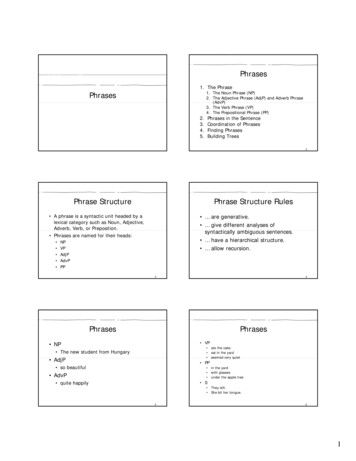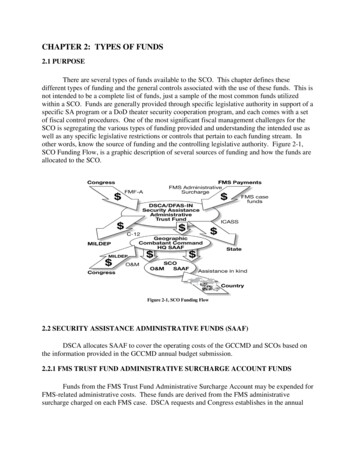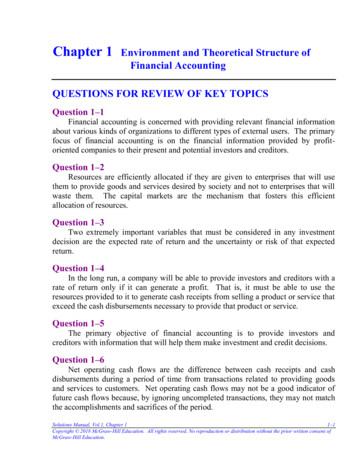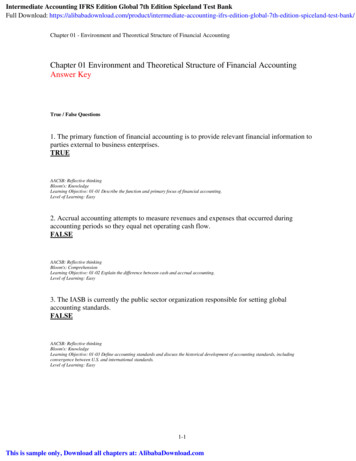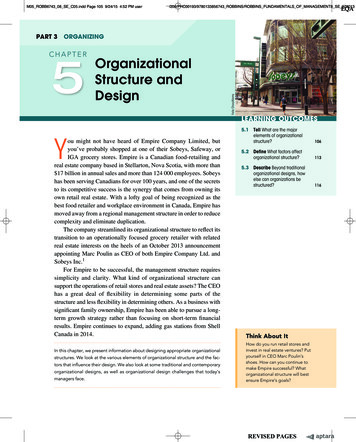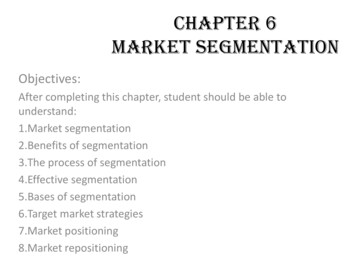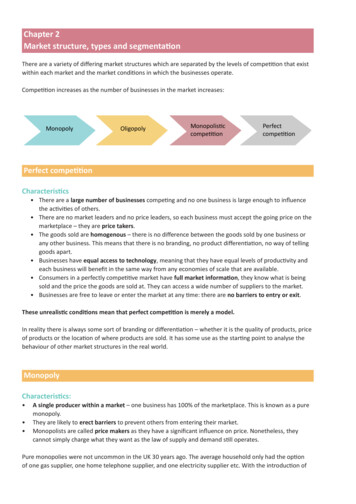
Transcription
Chapter 2Market structure, types and segmentationThere are a variety of differing market structures which are separated by the levels of competition that existwithin each market and the market conditions in which the businesses operate.Competition increases as the number of businesses in the market PerfectcompetitionPerfect competitionCharacteristics There are a large number of businesses competing and no one business is large enough to influencethe activities of others. There are no market leaders and no price leaders, so each business must accept the going price on themarketplace – they are price takers. The goods sold are homogenous – there is no difference between the goods sold by one business orany other business. This means that there is no branding, no product differentiation, no way of tellinggoods apart. Businesses have equal access to technology, meaning that they have equal levels of productivity andeach business will benefit in the same way from any economies of scale that are available. Consumers in a perfectly competitive market have full market information, they know what is beingsold and the price the goods are sold at. They can access a wide number of suppliers to the market. Businesses are free to leave or enter the market at any time: there are no barriers to entry or exit.These unrealistic conditions mean that perfect competition is merely a model.In reality there is always some sort of branding or differentiation – whether it is the quality of products, priceof products or the location of where products are sold. It has some use as the starting point to analyse thebehaviour of other market structures in the real world.MonopolyCharacteristics: A single producer within a market – one business has 100% of the marketplace. This is known as a puremonopoly.They are likely to erect barriers to prevent others from entering their market.Monopolists are called price makers as they have a significant influence on price. Nonetheless, theycannot simply charge what they want as the law of supply and demand still operates.Pure monopolies were not uncommon in the UK 30 years ago. The average household only had the optionof one gas supplier, one home telephone supplier, and one electricity supplier etc. With the introduction of
competition into these markets through deregulation and privatisation, these monopolies have in the maindisappeared. Until recently the Royal Mail had a monopoly over the delivery of letters in the UK, but eventhis is now opening up to competition.Pure monopolies with 100% of the market are now very rare.The UK and EU competition authorities regard any business with over 25% of the market as having potentialmonopoly power, and will investigate situations where it believes this power is being abused.Monopolies can, however, offer advantages to consumers. Being big or very big they can benefit frommassive economies of scale, reducing prices and making goods affordable. Also the profits earned canbe used for investment into improving products, improving production techniques and developing newproducts.Oligopoly – oligopolistic competitionCharacteristics: There are many businesses but only a few dominate the market.Each business tends to have differentiated products with a strong brand identity.Brand loyalty is encouraged by the use of heavy advertising and promotion.Prices can be stable for long periods, although short price wars do occur.Some barriers to entry do exist: for example, high start-up costs in relation to manufacturing.Many of our largest industries, whether manufacturing, retailing or service industries, are oligopolistic innature. In retailing, the grocery market is dominated by Tesco, Sainsbury’s, Morrisons and Asda. In clothingretailing, each age group have just three or four major chain stores that dominate their marketplace.When businesses in an oligopolistic market act together (collude), a cartel is formed. Cartels try to keepprices high, whilst the businesses involved share the market between themselves. This type of collusion hasoccurred in a wide range of industries: for example, the airline industry and the sports clothing industry. Thisformal collusion is illegal.However, oligopolies are not without advantages to consumers. Large size leads to economies of scale,high profits means money for innovation and investment, and oligopolies targeting a wide range of marketsegments provide variety and choice. A very good example of the advantages of the oligopolistic marketstructure can be found in communications. By communications we mean mobile phones, landlines, theinternet and television. A small number of very large businesses have put huge amounts of investment intothese industries over the last 30 years, meaning that service and customer choice has improved dramatically.Monopolistic competitionCharacteristics: A large number of relatively small businesses in competition with each other.There are few barriers to entry.Products are similar, but differentiated from each other.Brand identity is relatively weak.Businesses are not price takers; however, they only have a limited degree of control over the pricesthey charge.
You are likely to be aware of local business in specific markets that are quite similar to each other – forexample, hairdressers or take-away restaurants. Within every monopolistic market sector each businesstries to offer something different and possess an element of uniqueness, but all are essentially competingfor the same customers. Differentiation may take a number of forms in this market structure. For example,businesses could use physical product differentiation. This is where businesses use size, design, colour, shape,performance and features to make their products different from competitor businesses. For example, pizzaoutlets produce their products with stuffed crusts, thin and thick bases and in all shapes and sizes. They mayalso attempt differentiation through methods of purchase and distribution such as online purchases and freedelivery. Often attached to delivery is a promotional promise such as ‘if we are late you get it for free’.Market structure, types and segmentationhttp://bit.ly/1lqP9xswwwBusinesses and marketsDifferent businesses can operate in very different markets – some are local, others global. Some businessesare focussed on consumer markets (B2C), others sell to other businesses (B2B). For many businesses therewill be large seasonal variations in their sales; others may find much more constant sales throughout theyear. Although mass market businesses may seem to dominate the retail world there is still plenty of spacefor niche market businesses. Each business will still use the marketing mix, but how they adapt their strategydepends largely upon the target market. In most markets there is one dominant (mass) segment and severalsmaller (niche) segments.
Mass marketingMassmarketingThis is when a business targets its advertising and promotionalspending at the whole market, not at a particular segment. Itinvolves the marketing of a good or service to all possibleconsumers in the same way.Economies of scale can be taken advantage ofbecause of higher production output and capacity.Mass-produced vehicles such as those produced byToyota target a global mass market.Low-cost operations, heavy promotion, widespreaddistribution and the development of market-leadingbrands are key features.The costs of setting up in order to compete in amass market can be very high and competitioncan be very fierce, as Coca Cola and Pepsi Colaclearly show.Niche marketingNiche marketing is where a business targets a smaller segment of a larger market, where customers havespecific needs and wants. One or more specific segments of the market are targeted with niche marketing. A higher price can often be charged – customers are prepared to pay for expertise and tend to be loyal. There must be a full understanding of the desires and needs of the niche. This understanding canbe gained through market research, but is often initially based on more of a ‘gut feeling’ and anunderstanding that comes through personal experience. Niche marketing businesses are able to concentrate on their strengths, developing products fromwhat the business is good at. As niche businesses can gain expert knowledge of the targeted part ofthe market, their products or services directly meet the needs of customers, giving the niche marketingbusiness a real advantage over potential competitors. Lower start-up costs help niche market businesses in their early stages. The business may have themarket to themselves (at least for a while), because competition may ignore the niche, either becauseof lack of awareness or because it is too small for large businesses to focus on. However, market niches can disappear as a result of changes in economic conditions, fashion or taste. Alternatively, mass market businesses can target the niche if it grows in value or size and existingsmall businesses may find this competition impossible to deal with.
Market segmentationA market segment is any sub-group of a larger market. Mass market businesses divide their target marketsinto segments (sub-groups) that have common features, or are made up of individuals that make purchasingdecisions based on common factors. When this is done businesses produce and market products aimed ateach of these segments.Types of segmentationDemographicAge, social class,gender, income.Example: Banksoffer differentaccounts todifferent age groups.PsychographicAllows targeting ofgroups on personalityand emotionally basedbehaviour – attitudes,opinions and lifestyles.Example: Differentiatingcars by emphasisingdifferent features –safety and capacityfor the family car.Regions of the country –rural, urban, suburban.Global marketing oftenrequires different productsfor different countries.Example: Global brandssuch as McDonaldsand Coca Cola requiredifferent ingredientsin different countries.GeographicWhat rules must apply to market segmentation? Firstly, segments must be recognisable. They must be different enough from other segments to makeproducing for that segment worthwhile. For example, housing is built for different groups of people:flats for single people, two bedroom houses and starter homes for young couples, three or fourbedroom houses for families, bungalows for retired people. Also segments must have critical mass. This means that they must be big enough or produce enoughsales value to make the production of products or services targeted at the segment worthwhile. Themarket for two-seater sports cars has grown rapidly in recent years making the segment attractive: notonly to niche market businesses such as Lotus, but also to mass market businesses like Toyota, Hondaand Nissan. Segments have to be targetable. Having their own identity means that they can be promoted to, andhave marketing directed towards them. On daytime TV, there are many adverts for retirement plans,or funeral expenses plans, often sold in a reassuring but concerned manner. They are targeted at asegment which is aware of the potential problems of costly funeral expenses, or leaving a loved onewithout financial support.Once segments have been identified, then businesses can use a segment-orientated marketing approach.This approach offers a number of advantages for both businesses and customers. Targeted marketing allowsthe business to stress those product features that are most relevant for each particular segment (e.g. pricevs. quality vs. brand identity). This targeting will occur even if the product being sold to different segments isalmost identical.
Finally, customers change their preferences and patterns of behaviour over time (the customer life cycle).Sustainable customer relationships in all phases of the customer life cycle can come from segmentingmarkets. Businesses that serve different segments along a customer’s life cycle can lead their customersfrom stage to stage by always offering them a special solution for their particular needs. For example, mostcar manufacturers offer a product range that caters for the needs of all phases of a customer life cycle: a firstcar for students/young workers, a fun car for young professionals, a family car for young families, SUV forgrowing families etc. Skincare cosmetics brands often offer a branded series of products for babies, teens,young adults, mums, and more mature skin.Market segmentationhttp://bit.ly/1WqJSU2wwwGlobal marketsGlobal marketing is all about selling goods or services to overseas markets. With global marketing differentmarketing strategies are implemented, based on the region or country the company is marketing to. This maymean different packaging, pricing and promotional strategies.When businesses are considering moving into overseas markets there are several possible advantages. Higher earnings – firstly there are likely to be higher earnings, especially if margins in overseas marketsmay exceed those found at home. Spread risks – by moving into new markets risks are now spread. Decline in one market may besmoothed out by increased demand in an overseas market. Saturation of the home market – often businesses are encouraged to make their first moves intoa global market because of saturation of the home market – the business may have the finance toexpand, but be unable to do so because of competition. Economies of scale – this move into global markets is likely to lead to increased economies of scale. Survival – some businesses need to be global to survive, for example automobile businesses. Thebiggest of these companies (Ford, GM, Toyota, and VW) will not have the sales volumes in domesticmarkets to fully support their operations. The trick for these businesses is to design products that will,with perhaps a few adjustments, meet the needs of a number of consumers in a number of individualmarkets.Trade markets (B2B)Trad
Market segmentation A market segment is any sub-group of a larger market. Mass market businesses divide their target markets into segments (sub-groups) that have common features, or are made up of individuals that make purchasing decisions based on common factors. When this is done businesses produce and market products aimed at

